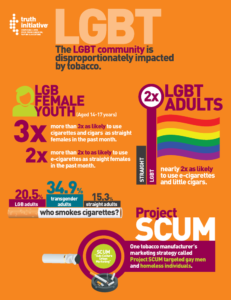LGBTQ+ Targeting & POS Tobacco
Targeted Marketing & Disparities
Targeted marketing of tobacco products to the LGBTQ+ community has been going on for decades through various methods, including advertising in gay press publications, participating in advocacy efforts for LGBTQ+ communities, corporate giving, and using strategic ad campaigns to appeal to LGBTQ+ consumers. In many cases, these campaigns feature messaging of freedom and choice that mirror language used by LGBTQ+ activists. For example, in 2001, a Lucky Strike spread featured a lesbian couple along with the phrase “I Choose.” And in 2005, American Spirit—a Reynolds subsidiary—launched an ad listing various “freedoms,” including “freedom to choose” and “freedom to marry” along with “freedom to inhale.” In 2015, an advertisement for e-cigarette brand blu featured a drag queen.

Research shows this advertising is effective. In an analysis of data from the 2003- 2006 Washington State Behavioral Risk Factor Surveillance System (BRFSS), lesbian, gay, and bisexual adults reported significantly greater exposure and receptiveness to tobacco industry marketing than heterosexual peers.[1]
This targeted marketing, along with the cumulative impacts of stress from discrimination and stigma, as well as lack of access to appropriate healthcare all contribute to higher tobacco use rates among the LGBTQ+ community. Evidence shows that LGBTQ+ individuals smoke at a higher rate than the population as a whole.[2] According to the 202 National Health Interview Survey, 25.1% of LGBTQ+ individuals use any form of tobacco compared to 18.8% of heterosexual individuals.[3] Rates of smoking and tobacco use also vary among sub-poulations of the LGBTQ+ community – for instance, while data is limited, some studies have shown that tobacco use rates are as high as 33% among people who are transgender,[4] and people who are transgender and gender diverse are 2-3 times as likely as people who are cisgender to use tobacco products. [5] In particular, the use of menthol products, which have been historically excluded in flavor bans, is disproportionately high among LGBTQ+ smokers.[6]
Another driver of the disparities in tobacco use is differences in retailer density. A higher density of tobacco retailer outlets has been found in areas where greater numbers of LGBTQ+ couples live,[7] which can lead to increased access to tobacco products and greater exposure to advertising.
These disparities in smoking rates can also be attributed to Big Tobacco’s efforts to target the LGBTQ+ community with strategies that mirror targeted marketing efforts of African Americans. As one example, according to internal industry documents from the mid-90s, R.J. Reynolds created a marketing strategy called “Project SCUM” (Sub-Culture Urban Marketing) to boost cigarette sales by targeting young gay men and homeless individuals with advertisements, displays, and low prices placed strategically in communities and stores.
 Resources
Resources
Learn more about the tobacco industry’s targeting of LGBTQ+ communities through these resources:
- Counter Tobacco’s LGBTQ Tobacco Use podcast
- Public Health Law Center’s webinar’s Pride in Policy: Advancing the Health of the LGBTQ+ Community and Pride and Prejudice: The Tobacco Industry’s Co-Opting of the LGBTQ+ Community
- Truth Initiative’s fact sheet Tobacco Use in LGBT Communities
There are several public education campaigns designed to reduce tobacco use in the LGBTQ+ community and counter the tobacco industry’s targeted marketing.
- FDA’s “This Free Life” campaign
- National LGBT Cancer Network “Out Proud Free”
POS policy solutions
Policies that restrict tobacco product availability can help to counteract the tobacco industry’s efforts to attract new, current and recently quit smokers. Because of the disproportionate number of LGBTQ+ smokers who use flavored products, policies that ban all flavored tobacco products, including menthol, are especially important to protecting the health of the LGBTQ+ community.
Policies that limit the number of retailers in a community through zoning and licensing are effective ways to reduce community exposure to tobacco products and marketing. Policies that impact what can be sold in stores near schools may also reduce youth smoking initiation. Check out information on using licensing and zoning to reduce retailer density.


